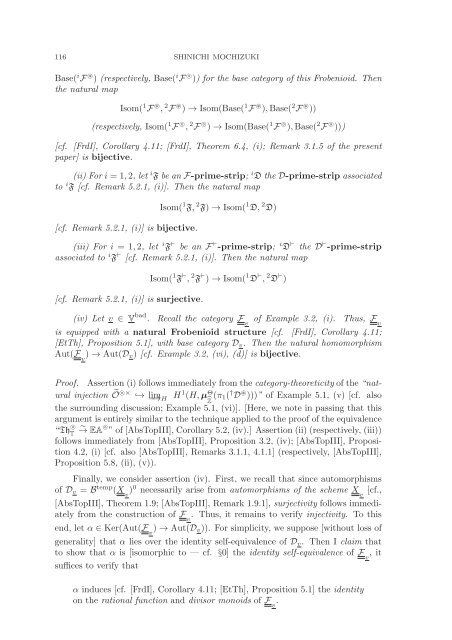Inter-universal Teichmuller Theory I: Construction of Hodge Theaters
Inter-universal Teichmuller Theory I: Construction of Hodge Theaters
Inter-universal Teichmuller Theory I: Construction of Hodge Theaters
Create successful ePaper yourself
Turn your PDF publications into a flip-book with our unique Google optimized e-Paper software.
116 SHINICHI MOCHIZUKI<br />
Base( i F ⊛ ) (respectively, Base( i F ⊚ )) for the base category <strong>of</strong> this Frobenioid. Then<br />
the natural map<br />
Isom( 1 F ⊛ , 2 F ⊛ ) → Isom(Base( 1 F ⊛ ), Base( 2 F ⊛ ))<br />
(respectively, Isom( 1 F ⊚ , 2 F ⊚ ) → Isom(Base( 1 F ⊚ ), Base( 2 F ⊚ )))<br />
[cf. [FrdI], Corollary 4.11; [FrdI], Theorem 6.4, (i); Remark 3.1.5 <strong>of</strong> the present<br />
paper] is bijective.<br />
(ii) For i =1, 2, let i F be an F-prime-strip; i D the D-prime-strip associated<br />
to i F [cf. Remark 5.2.1, (i)]. Then the natural map<br />
[cf. Remark 5.2.1, (i)] is bijective.<br />
Isom( 1 F, 2 F) → Isom( 1 D, 2 D)<br />
(iii) For i =1, 2, let i F ⊢ be an F ⊢ -prime-strip; i D ⊢ the D ⊢ -prime-strip<br />
associated to i F ⊢ [cf. Remark 5.2.1, (i)]. Then the natural map<br />
[cf. Remark 5.2.1, (i)] is surjective.<br />
Isom( 1 F ⊢ , 2 F ⊢ ) → Isom( 1 D ⊢ , 2 D ⊢ )<br />
(iv) Let v ∈ V bad . Recall the category F v<br />
<strong>of</strong> Example 3.2, (i). Thus, F v<br />
is equipped with a natural Frobenioid structure [cf. [FrdI], Corollary 4.11;<br />
[EtTh], Proposition 5.1], with base category D v . Then the natural homomorphism<br />
Aut(F v<br />
) → Aut(D v ) [cf. Example 3.2, (vi), (d)] is bijective.<br />
Pro<strong>of</strong>. Assertion (i) follows immediately from the category-theoreticity <strong>of</strong> the “natural<br />
injection Õ⊚× ↩→ lim −→H H 1 (H, μ Θ(π 1( † D ⊛ )))” <strong>of</strong> Example 5.1, (v) [cf. also<br />
Ẑ<br />
the surrounding discussion; Example 5.1, (vi)]. [Here, we note in passing that this<br />
argument is entirely similar to the technique applied to the pro<strong>of</strong> <strong>of</strong> the equivalence<br />
“Th ⊚ ∼<br />
T<br />
→ EA ⊚ ” <strong>of</strong> [AbsTopIII], Corollary 5.2, (iv).] Assertion (ii) (respectively, (iii))<br />
follows immediately from [AbsTopIII], Proposition 3.2, (iv); [AbsTopIII], Proposition<br />
4.2, (i) [cf. also [AbsTopIII], Remarks 3.1.1, 4.1.1] (respectively, [AbsTopIII],<br />
Proposition 5.8, (ii), (v)).<br />
Finally, we consider assertion (iv). First, we recall that since automorphisms<br />
<strong>of</strong> D v = B temp (X v<br />
) 0 necessarily arise from automorphisms <strong>of</strong> the scheme X v<br />
[cf.,<br />
[AbsTopIII], Theorem 1.9; [AbsTopIII], Remark 1.9.1], surjectivity follows immediately<br />
from the construction <strong>of</strong> F v<br />
. Thus, it remains to verify injectivity. To this<br />
end, let α ∈ Ker(Aut(F v<br />
) → Aut(D v )). For simplicity, we suppose [without loss <strong>of</strong><br />
generality] that α lies over the identity self-equivalence <strong>of</strong> D v . Then I claim that<br />
to show that α is [isomorphic to — cf. §0] the identity self-equivalence <strong>of</strong> F v<br />
,it<br />
suffices to verify that<br />
α induces [cf. [FrdI], Corollary 4.11; [EtTh], Proposition 5.1] the identity<br />
on the rational function and divisor monoids <strong>of</strong> F v<br />
.
















